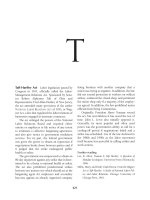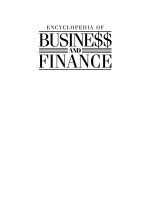Business finance ch 16 financing current assets
Bạn đang xem bản rút gọn của tài liệu. Xem và tải ngay bản đầy đủ của tài liệu tại đây (107.63 KB, 24 trang )
CHAPTER 16
Financing Current Assets
Working capital financing
policies
A/P (trade credit)
Commercial paper
S-T bank loans
16-1
Working capital financing
policies
Moderate – Match the maturity of
the assets with the maturity of the
financing.
Aggressive – Use short-term
financing to finance permanent
assets.
Conservative – Use permanent
capital for permanent assets and
temporary assets.
16-2
Moderate financing policy
$
Temp. C.A.
S-T
Loans
Perm C.A.
Fixed Assets
L-T Fin:
Stock,
Bonds,
Spon. C.L.
Years
Lower dashed line would be more aggressive.
16-3
Conservative financing
policy
$
Marketable
securities
Perm C.A.
Zero S-T
Debt
L-T Fin:
Stock,
Bonds,
Spon. C.L.
Fixed Assets
Years
16-4
Short-term credit
Any debt scheduled for repayment within
one year.
Major sources of short-term credit
Accounts payable (trade credit)
Bank loans
Commercial loans
Accruals
From the firm’s perspective, S-T credit is
more risky than L-T debt.
Always a required payment around the
corner.
May have trouble rolling over loans.
16-5
Advantages and disadvantages
of using short-term financing
Advantages
Speed
Flexibility
Lower cost than long-term debt
Disadvantages
Fluctuating interest expense
Firm may be at risk of default as a result
of temporary economic conditions
16-6
Accrued liabilities
Continually recurring short-term
liabilities, such as accrued wages or
taxes.
Is there a cost to accrued liabilities?
They are free in the sense that no
explicit interest is charged.
However, firms have little control over
the level of accrued liabilities.
16-7
What is trade credit?
Trade credit is credit furnished by a
firm’s suppliers.
Trade credit is often the largest
source of short-term credit,
especially for small firms.
Spontaneous, easy to get, but cost
can be high.
16-8
The cost of trade credit
A firm buys $3,000,000 net ($3,030,303
gross) on terms of 1/10, net 30.
The firm can forego discounts and pay
on Day 40, without penalty.
Net daily purchases = $3,000,000 /
365
= $8,219.18
16-9
Breaking down net and gross
expenditures
Firm buys goods worth $3,000,000.
That’s the cash price.
They must pay $30,303 more if they
don’t take discounts.
Think of the extra $30,303 as a
financing cost similar to the interest
on a loan.
Want to compare that cost with the
cost of a bank loan.
16-10
Breaking down trade credit
Payables level, if the firm takes discounts
Payables level, if the firm takes no
discounts
Payables = $8,219.18 (10) = $82,192
Payables = $8,219.18 (40) = $328,767
Credit breakdown
Total trade credit $328,767
Free trade credit - 82,192
Costly trade credit $246,575
16-11
Nominal cost of costly trade
credit
The firm loses 0.01($3,030,303)
= $30,303 of discounts to obtain
$246,575 in extra trade credit:
kNOM
= $30,303 / $246,575
= 0.1229 = 12.29%
The $30,303 is paid throughout the
year, so the effective cost of costly
trade credit is higher.
16-12
Nominal trade credit cost
formula
Discount%
365days
kNOM
1 - Discount% Daystaken- Disc.period
1
365
99 40 - 10
0.1229
12.29%
16-13
Effective cost of trade
credit
Periodic rate = 0.01 / 0.99 = 1.01%
Periods/year = 365 / (40-10) =
12.1667
Effective cost of trade credit
EAR = (1 + periodic rate)n – 1
= (1.0101)12.1667 – 1 = 13.01%
16-14
Commercial paper (CP)
Short-term notes issued by large,
strong companies. B&B couldn’t
issue CP--it’s too small.
CP trades in the market at rates just
above T-bill rate.
CP is bought with surplus cash by
banks and other companies, then
held as a marketable security for
liquidity purposes.
16-15
Bank loans
The firm can borrow $100,000 for 1
year at an 8% nominal rate.
Interest may be set under one of
the following scenarios:
Simple annual interest
Discount interest
Discount interest with 10%
compensating balance
Installment loan, add-on, 12 months
16-16
Must use the appropriate EARs
to evaluate the alternative loan
terms
Nominal (quoted) rate = 8% in all cases.
We want to compare loan cost rates and
choose lowest cost loan.
We must make comparison on EAR =
Equivalent (or Effective) Annual Rate
basis.
16-17
Simple annual interest
“Simple interest” means no discount or
add-on.
Interest = 0.08($100,000) = $8,000
kNOM = EAR = $8,000 / $100,000 = 8.0%
For a 1-year simple interest loan, kNOM =
EAR
16-18
Discount interest
Deductible interest = 0.08 ($100,000)
= $8,000
Usable funds = $100,000 - $8,000
= $92,000
INPUTS
1
N
OUTPUT
I/YR
92
0
-100
PV
PMT
FV
8.6957
16-19
Raising necessary funds with
a discount interest loan
Under the current scenario, $100,000
is borrowed but $8,000 is forfeited
because it is a discount interest loan.
Only $92,000 is available to the firm.
If $100,000 of funds are required, then
the amount of the loan should be:
Amt borrowed = Amt needed / (1 – discount)
= $100,000 / 0.92 = $108,696
16-20
Discount interest loan with a
10% compensating balance
Amountneeded
Amountborrowed
1 - discount- comp.balance
$100,000
$121,951
1 - 0.08- 0.1
Interest = 0.08 ($121,951) = $9,756
Effective cost = $9,756 / $100,000 =
9.756%
16-21
Add-on interest on a 12month installment loan
Interest = 0.08 ($100,000) = $8,000
Face amount = $100,000 + $8,000 = $108,000
Monthly payment = $108,000/12 = $9,000
Avg loan outstanding = $100,000/2 = $50,000
Approximate cost = $8,000/$50,000 = 16.0%
To find the appropriate effective rate, recognize
that the firm receives $100,000 and must
make monthly payments of $9,000. This
constitutes an annuity.
16-22
Installment loan
From the calculator output below, we have:
kNOM
= 12 (0.012043)
= 0.1445 = 14.45%
EAR = (1.012043)12 – 1 = 15.45%
INPUTS
12
N
OUTPUT
I/YR
100
-9
0
PV
PMT
FV
1.2043
16-23
What is a secured loan?
In a secured loan, the borrower
pledges assets as collateral for the
loan.
For short-term loans, the most
commonly pledged assets are
receivables and inventories.
Securities are great collateral, but
generally not available.
16-24









